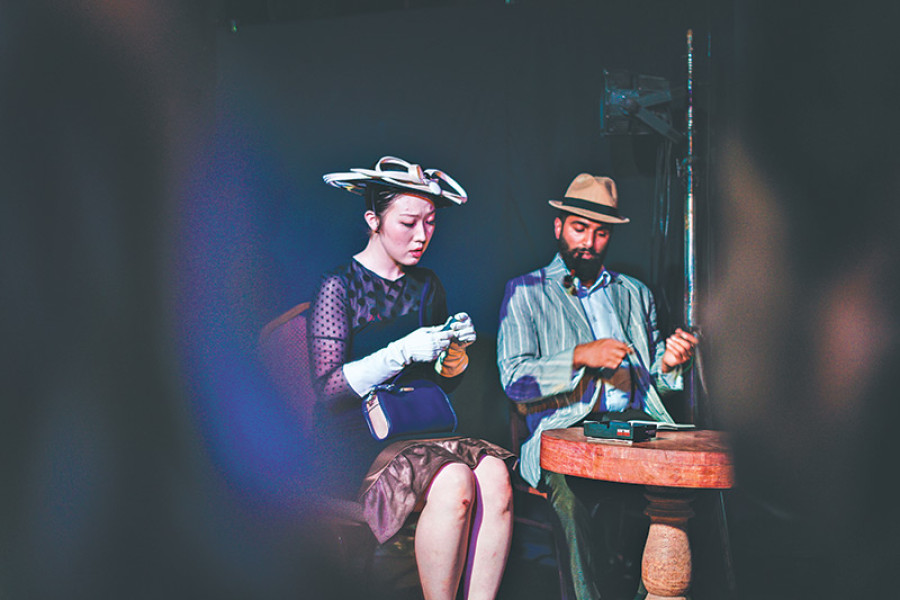Entertainment
Kathmandu’s own vaudeville ‘bill’
Recently, Club 25 Hours at Tangalwood hosted quite an extraordinary show over two weekends.
Kurchi Dasgupta
Recently, Club 25 Hours at Tangalwood hosted quite an extraordinary show over two weekends. A cast of eleven, under the able direction of danseuse Alizé Biannic, brought the dark interiors of the night club to life in a production called Café de Flore. Named after one of the oldest coffee houses in Paris, the show expectedly had a French ambience and brought to us glimpses of the lives of the cafe’s imagined and varied clientele.
All eleven members of the cast, including Biannic herself, delivered a glittering couple of hours of entertainment. A mixture of contemporary choreography, classical ballet moves, verbal monologues, theatrical gestures, Chaplinesque comedy and music, Café de Flore comes as close to a vaudeville ‘bill’ or a cabaret show as one might ever hope to see in Nepal, in terms of form and structure. Through a string of disconnected acts and sequences, woven together with a clutch of repeating, essentialised stereotypes (like the rich man, the poor tramp, the abuser, the lover, the artist, the coquette, the rich but lonely woman, etc) the ‘bill’, or show, was quite enchanting in its distance from anything we might have experienced in this part of the world. The absence of a coherent storyline added to its staccato appeal and drew focus in what it succeeded best at: dance. Though many of the performers—Hemanta Chalise, Utpal Jha, Sandeep Shrestha and Sandesh Shakya, for instance—are not professional dancers, they held stage and beautifully so with the rest of the cast of highly skilled artistes like Vijaya Karki, Roni Shrestha, Siddhartha Rai, Siyoung Sing, Sezal Thapa and Rupen Thapa Magar. The movements varied between the repetitive ‘perpetuum mobile’ style of Uwe Scholz, the quotidian theatricality of Pina Bausch, the violent absurdity of Chaplin and the cabaret. It was quite a heady mix and performed almost to perfection in a space ideally suited for such a production. The verbalised narrations, however, came across as more an interruption than a necessity and in my opinion, could easily have been pared down or delivered through screen projections or placards. When delivered by actors, the words recovered their meanings but imposing them on dancers was perhaps the only flaw of the show.

Biannic herself is French and is a professional ballet dancer, who has trained extensively in Paris (Petits rats de l’Ecole de Danse de l’Opéra de Paris), in Leipzig (with the famous Uwe Scholz at Leipzig Ballet) and in London (Royal Academy of Dance). Armed with such extensive training and a career in classical ballet and modern choreography, she landed in Nepal in 2013 and has stayed on since to be our window to contemporary dance of the West.
Sandeep Shrestha was quite stunning in his mimicking of Chaplin’s Tramp in a Parisian café setting and so was Utpal Jha as a sizzling drag queen. Chalise’s intense performance made him stand out while Shakya delivered competently in each of his roles. Siyoung Sing was notable for her grace, Sezal Thapa for her intuitive artistry, Vijaya Karki for her mature handling of content. Rupen Thapa Magar, Roni Shrestha and Siddhartha Rai brought the evening alive with their incredibly supple and confident moves. The energy of the ensemble was palpable enough to keep the audience mesmerised throughout, helped as it was by a never-ending array of costume changes designed by Sagun Pokharel, Binita Gurung and Murielle Quenet. Ingi Hopokoinch Sunuwar’s light design was more than adequate. But the success of Café de Flore rested most on the beautiful music compiled by Biannic which ranged from Stravinsky, Pina Bausch through songs by Édith Piaf and Charles Dumont, to songs from films like Nine.
Café de Flore is one of those productions that need to be experienced rather than analysed, for its strength lies in performance to be enjoyed in the moment than a coherent narrative. What I found most interesting was the ease with which the show swung between elements of the intentionally ridiculous or burlesque on one hand and the dramatic seriousness of contemporary, Western choreography on the other. I certainly am looking forward to Solis Performing Arts’ next production, for Biannic seems all set in her mission to freshly define the dance scene of Kathmandu.




 10.12°C Kathmandu
10.12°C Kathmandu










